Arizona is packed with arid landscapes and contains part of four incredible deserts. These deserts provide habitats to some epic animals, some of which might be considered dangerous if you get too near them. This article examines the most dangerous animals in Arizona’s deserts, including some dangerous to humans and some hunters so dangerous to other animals they couldn’t stay off the list.
But first, what deserts exist in Arizona?
Where Are Arizona’s Deserts?
Arizona is the only state that contains all four U.S. deserts.
- Sonoran Desert: The best-known Arizonian desert stretches across southern Arizona and surrounds Tucson, Phoenix, Yuma, and Gila Bend.
- Mojave Desert: The driest desert in North America fills a small portion of Arizona’s northwest corner.
- Chihuahuan Desert: This grassy desert sits on Arizona’s southeastern tip and includes mountain ranges above 3,500 feet.
- Great Basin: In northeastern Arizona, the Great Basin contains the Grand Canyon region (although some folk consider it an entirely separate desert called the Navajo).
Each desert has its ecosystem with amazing animals, but what dangerous animals prowl, lurk, hunt, and hide in Arizona’s breathtaking deserts?
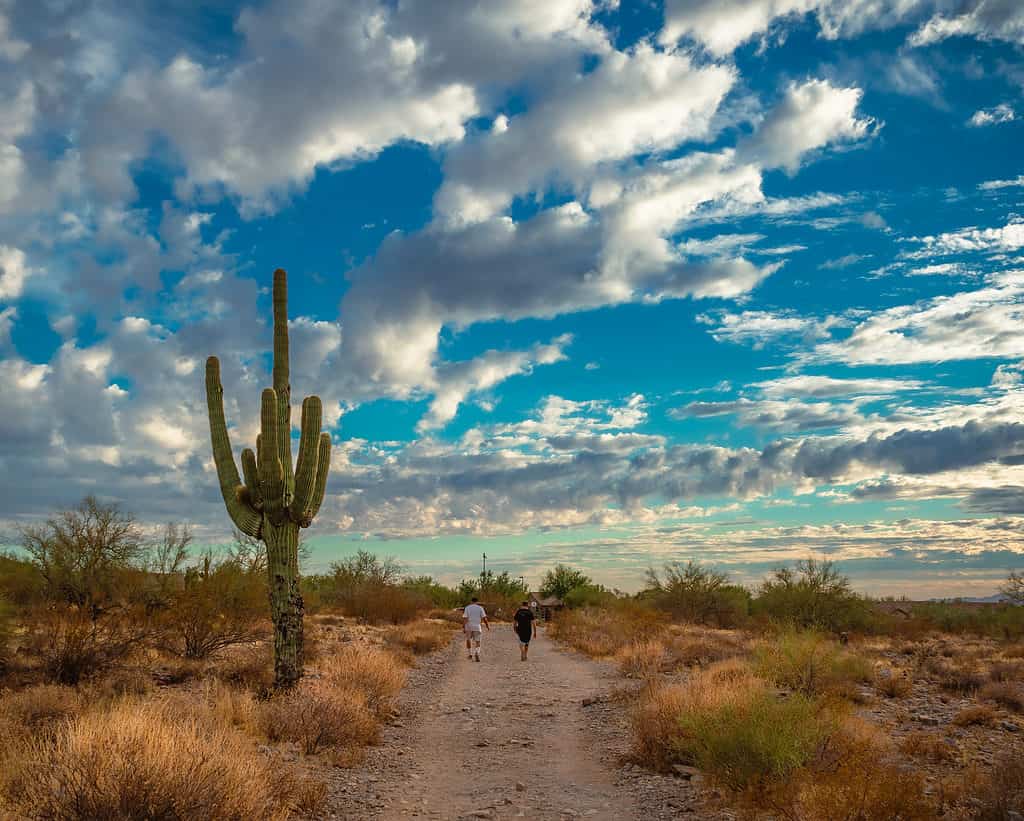
The Sonoran Desert stretches across southern Arizona.
©86Eric_Anthony_Mischke 86/Shutterstock.com
1. Western Diamondback Rattlesnake
The Western diamondback rattlesnake is a pit viper and the United States’ most venomous snake. It’s easy to identify with a tan body and its unique diamond-shaped rattle. This epic hunter grows four to six feet in length and weighs up to 15 pounds. In Arizona’s deserts, rattlers hunt rabbits, gophers, lizards, and ground-dwelling birds in the underbrush at night, sensing their body heat with a pit located behind each nostril.
It’s a dangerous animal indeed, more than capable of biting and killing a human, but bites are very rare. A diamondback rattlesnake would much rather escape our notice. They certainly don’t hunt or chase humans.
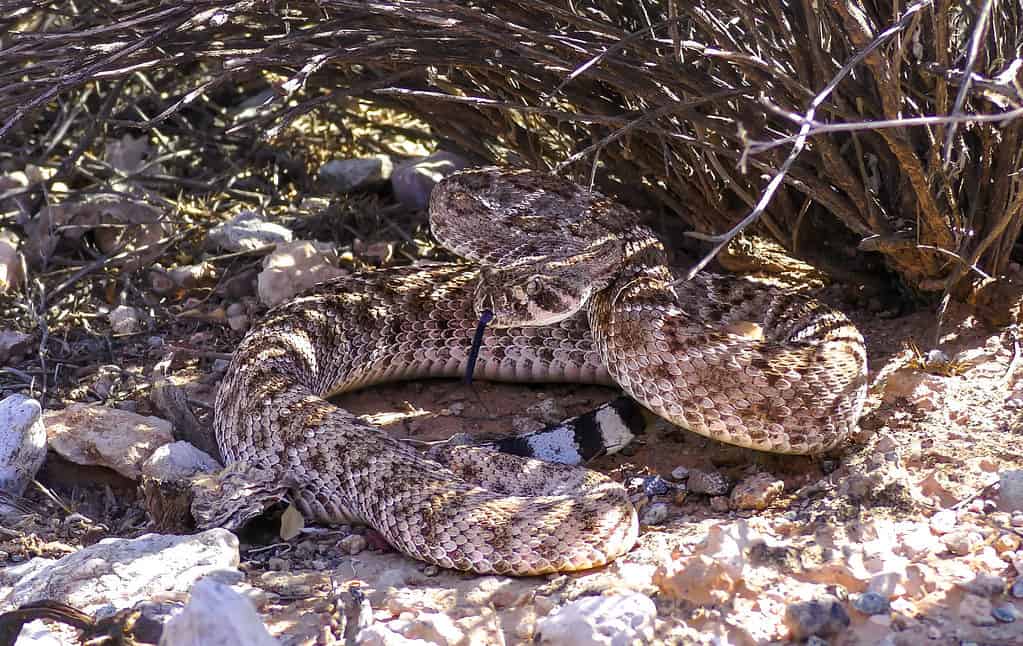
A western diamondback rattlesnake can reach six feet long.
©iStock.com/Banu R
2. Mountain Lion
Awesome mountain lions prowl Arizona’s desert regions, preferring rocky areas with brush or tree cover. Sometimes called cougars or pumas, these epic big cats are solitary nighttime hunters that prey on rodents, rabbits, and even snakes. Carnivorous mountain lions are shy, but if you ever see one, back away and make lots of noise. Don’t run because this might trigger their chase instinct.
Pumas reach 3-4 feet tall at their shoulder and reach eight feet long, including their tails. They can leap 20 feet up trees or 45 feet across chasms. However, unlike other big cats, they cannot roar.
The Arizona-Sonoran Museum traditionally adopts mountain lion cubs unsuitable for release into the wild. Their current resident is Cruz.
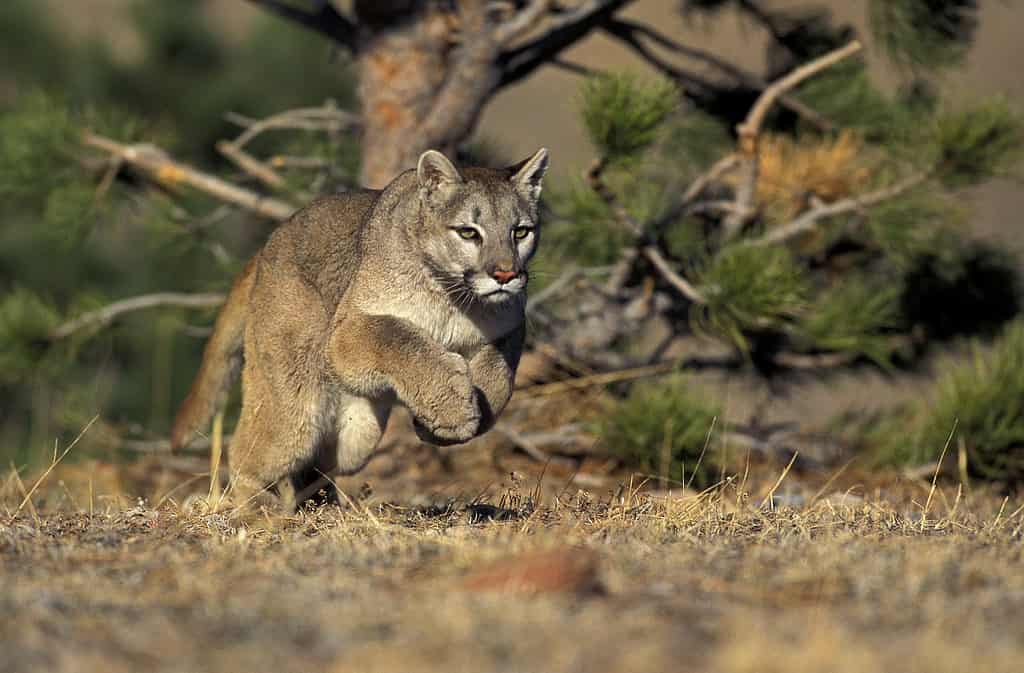
Mountain lions can leap 45 feet across chasms and jump 20 vertical feet.
©iStock.com/slowmotiongli
3. Arizona Bark Scorpion
Arizona is home to 40 scorpion species, but the Sonoran native brown bark scorpion is the most dangerous. It has eight legs, a pair of pinchers, a five-segmented tail with a venomous stinger, and, amazingly, an exoskeleton that glows blue in UV light.
Seven-inch-long females grow much larger than three-inch males, and they have up to 30 babies, which they carry around until they are large enough to make their way in the world. Their prey includes insects, mice, lizards, and spiders, but very little prey on a bark scorpion! Their few predators include owls, tarantulas, and amazing grasshopper mice that have evolved to neutralize bark scorpion venom.
A bark scorpion sting can kill a human, but it’s a rare event. Still, medical attention is important for all scorpion stings.
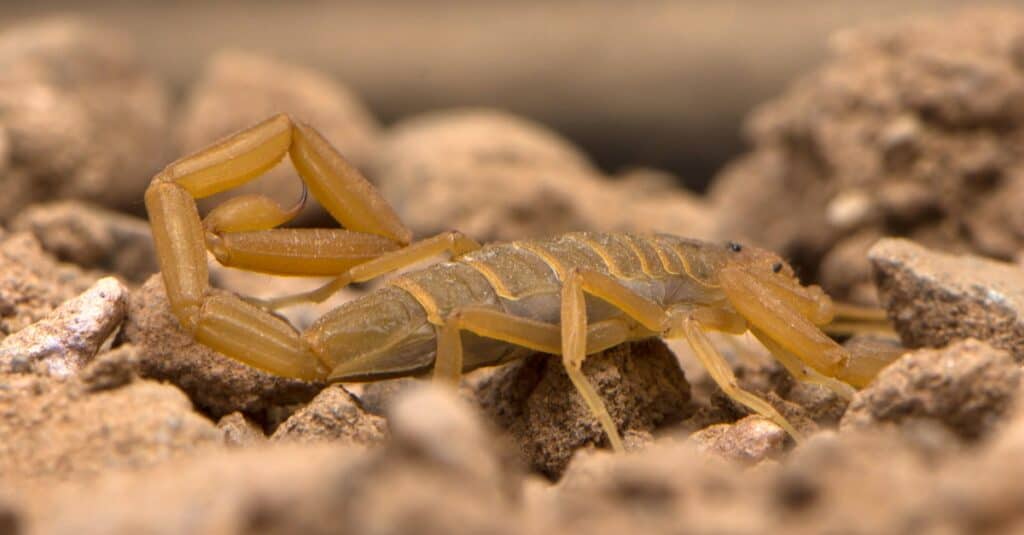
An Arizona bark scorpion’s exoskeleton glows blue under UV light.
©iStock.com/Ledzeppelinriff
4. Giant Desert Centipede
When we say giant, we mean giant compared to other centipedes! This “giant” reaches eight inches long and an inch wide. This fascinating creature walks on 42 legs and uses pinchers to grip its unfortunate insect, frog, and rodent victims before injecting venom. It’s not venomous enough to harm humans, but the pinch is incredibly painful, so take care to avoid them.
These massive brown centipedes are preyed on by owls, coyotes, and bobcats, so they hide under rocks during the day and emerge to hunt at night.
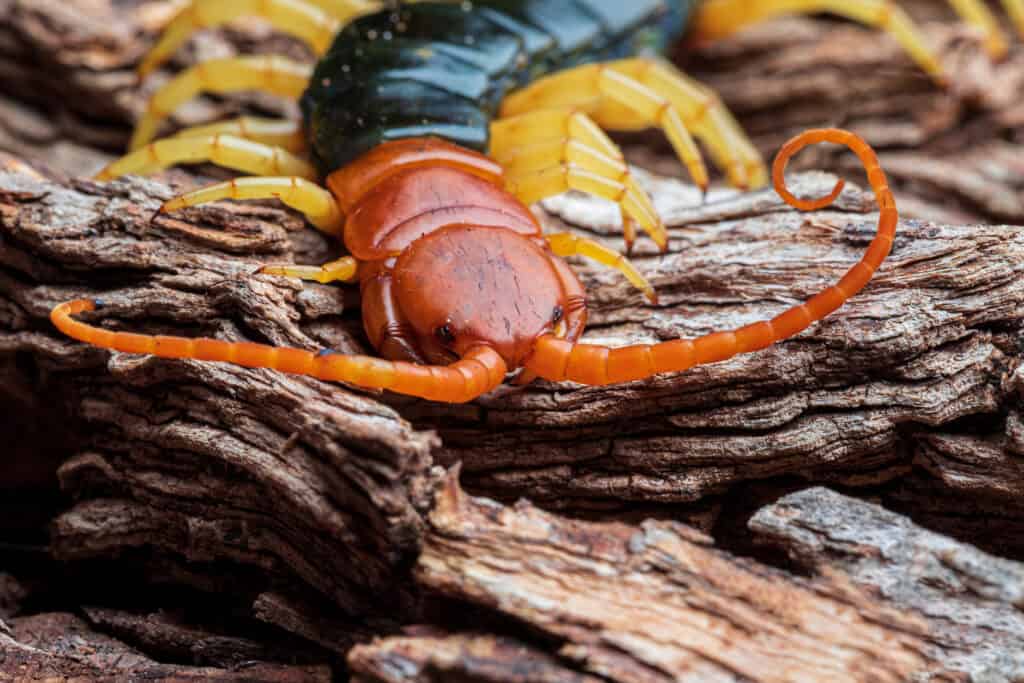
Giant desert centipedes reach an epic eight inches long.
©Scott Delony/Shutterstock.com
5. Gila Monster
Gila monster earns the title of most dangerous sounding animal in Arizona’s deserts, but in reality, the United States’ most giant lizard doesn’t pose much of a threat to humans. Their colorful beaded skin looks attractive, and their fat-storing tails give the impression of a cute chunky lizard, but they can give a nasty bite. Native Apache believed Gila monster breath was fatal.
They don’t emit death breath, but two-foot-long venomous gila monsters chomp down on lizards, birds, insects, and eggs dug up with their sharp claws. They prefer to live in desert scrub where suitable prey hangs out.

Gila monsters store fat in their tails to survive the lean winter months.
©Vaclav Sebek/Shutterstock.com
6. Sidewinder
Crotalus cerastes is the venomous sidewinder snake that’s also dubbed the horned rattlesnake due to the hornlike structures on its head.
This is another native Arizona pit viper, but it’s smaller than the diamondback rattlesnake we’ve already met. Sidewinders reach 18 to 32 inches long. They’re tan-colored, prey on mice, lizards, and birds, and get their descriptive name from a side-winding movement used to travel across hot shifting sand.
Two species live in Arizona’s deserts. The Mojave desert sidewinder and the Sonoran desert sidewinder. Their names explain it all, but the difference is that the Sonoran species has a black rattle underneath.
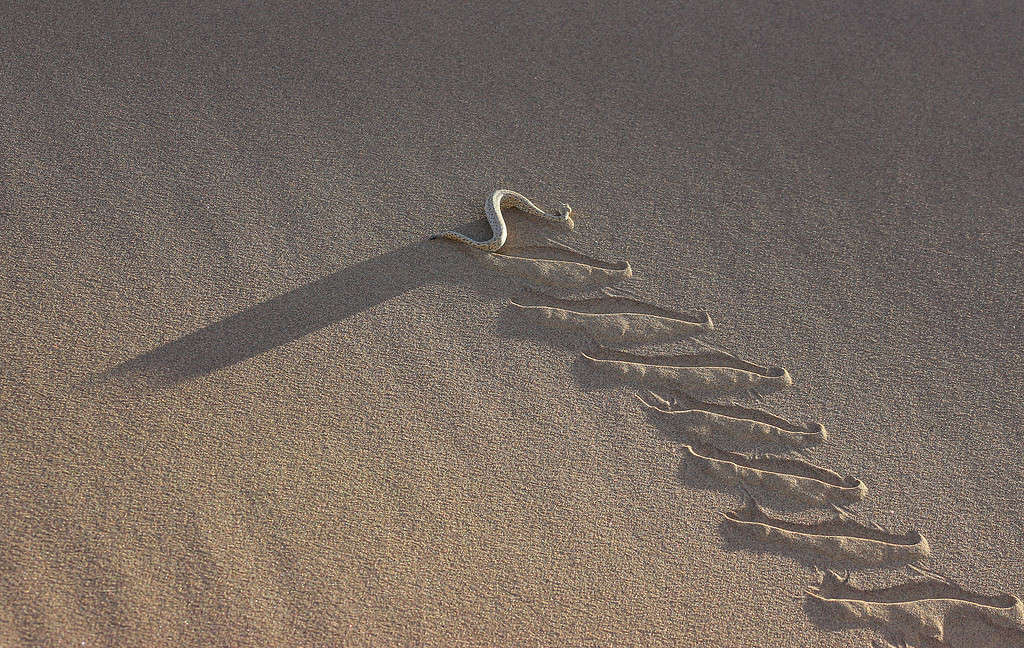
Sidewinder snakes move sideways to cope with hot shifting sands.
©Chantelle Bosch/Shutterstock.com
7. Golden Eagle
North America’s largest bird of prey is not dangerous to humans unless you try to pick one up, in which case its epic talons and beak are capable of deep lacerations. Still, it’s dangerous to snakes, rodents, rabbits, and pretty much all of the smaller desert residents.
This incredible bird has a seven-foot-wide wingspan but only weighs 12 pounds. It uses the desert’s hot rising air currents to soar around the vast skies scanning for prey on the ground.
A golden eagle’s scream sounds terrifying, but it’s used to communicate with its mate and youngsters that shelter in nests on mountainsides. Their habitat is somewhat scarce, so in the Mojave desert, the government has invested in a conservation program to protect their nests from aerial telecommunications.
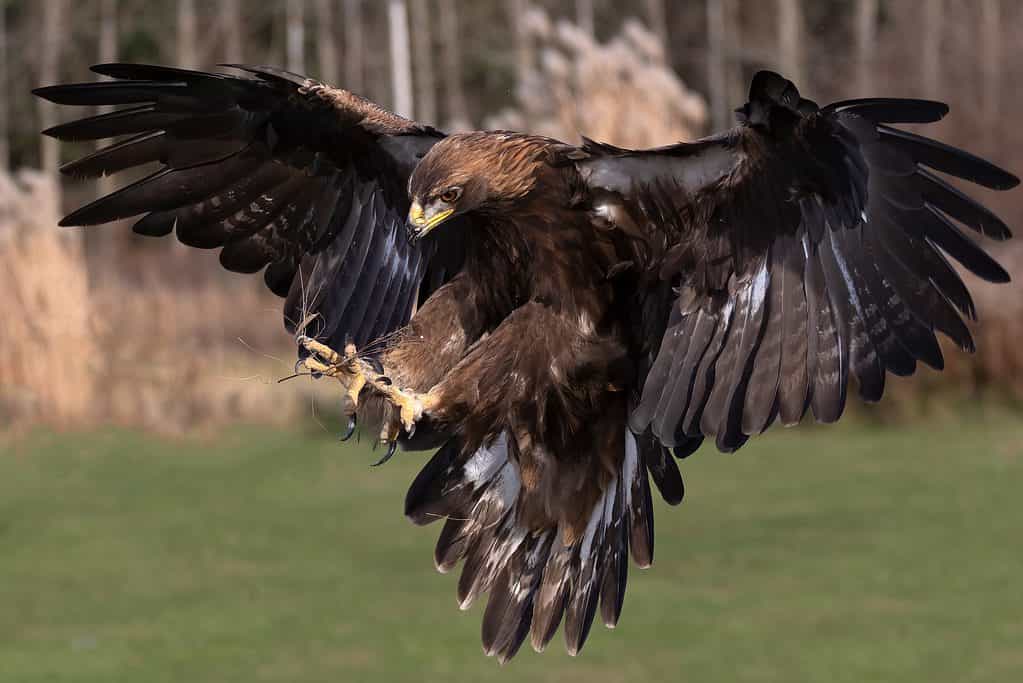
Golden eagles have an incredible seven feet wide wingspan but only weigh 12 pounds.
©Touched by light images/Shutterstock.com
8. Black Widow Spider
The black widow spider needs no introduction. It is one of Arizona’s two venomous desert spiders. The other is the brown recluse.
Black widows live in Arizona’s deserts and cities. They are fast, stealthy, and easy to recognize with their shiny black abdomens and red hourglass markings. Females reach a huge 1.5 inches long, and only the ladies carry venom. Male black widows reach half the size and don’t have venom.
A black widow bite causes pain, sweating, nausea, cramps, and breathing issues. Although they can kill humans, it’s very rare. They’re shy and only bite if provoked, preferring to keep their venom for insects trapped in their webs.
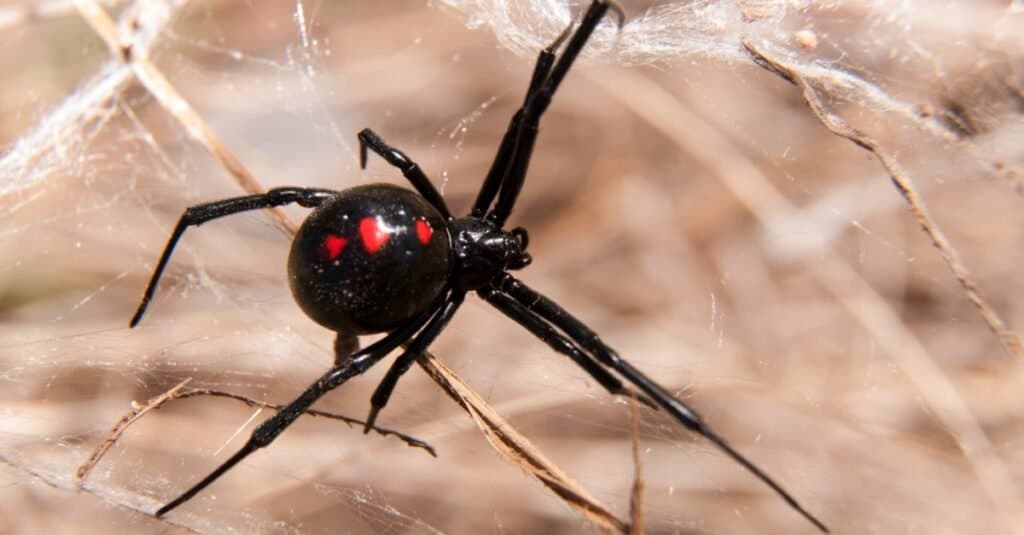
Only female black widow spiders have venom.
©Sari ONeal/Shutterstock.com
9. Jaguar
Although they’re exceedingly rare, jaguars live in Arizona’s desert regions because they’ve crossed the United States-Mexico border to extend their range. Only four jaguars have been spotted in Arizona’s Sonoran Desert since the 1990s.
Listed as endangered, this epic big cat is incredibly powerful. Unlike most big cats that suffocate their hapless victims, jaguars pierce skulls with their powerful jaws. Their prey in Arizona’s deserts is chiefly javelina and deer, but they take bighorn sheep, reptiles, and birds. Not much can escape a jaguar’s clutches, and their incredible stalking ability is so stealthy a victim won’t know anything until it’s caught.
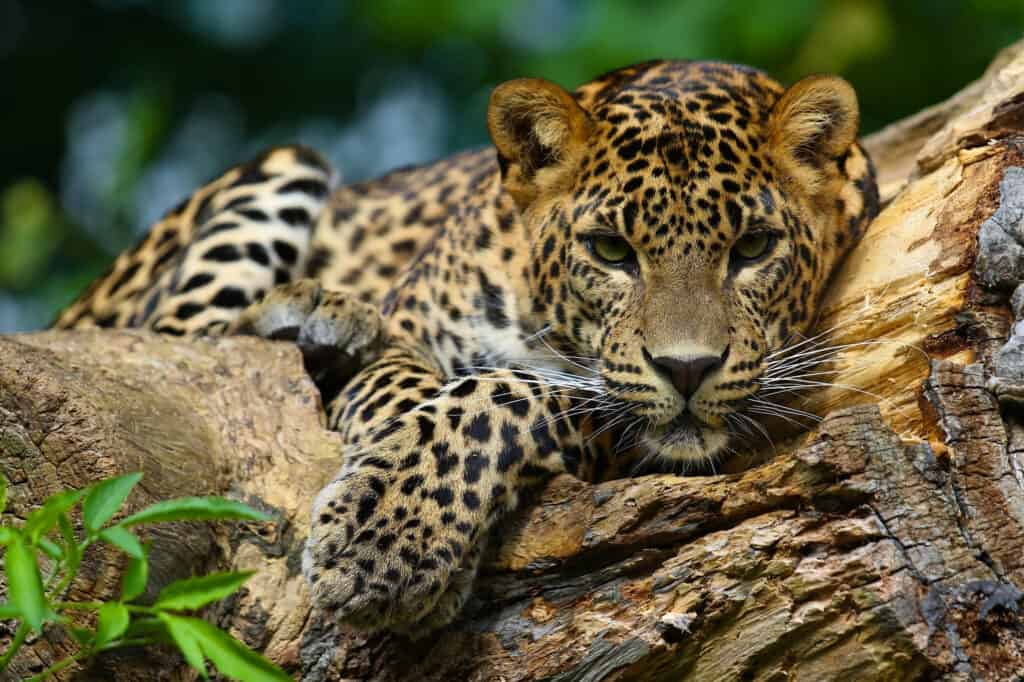
Jaguars cross the United States-Mexico border to extend their range.
©L-N/Shutterstock.com
10. Blister Beetles
Moving on to something different, we have blister beetles!
In Arizona’s deserts, blister beetles emerge during springtime. They reach 1.3 inches long and display striking red markings. Swarms emerge in the Mojave and Sonoran Deserts to mate before the females lay eggs in desert soil. Adult blister beetles eat plants, but their larvae offspring eat insects. Bees are a particular target.
During mating, these beetles emit a liquid called cantharidin from their joints which causes blisters that fend off predators. It’s so toxic it causes welts and painful patches on our skin, but it’s not fatal.
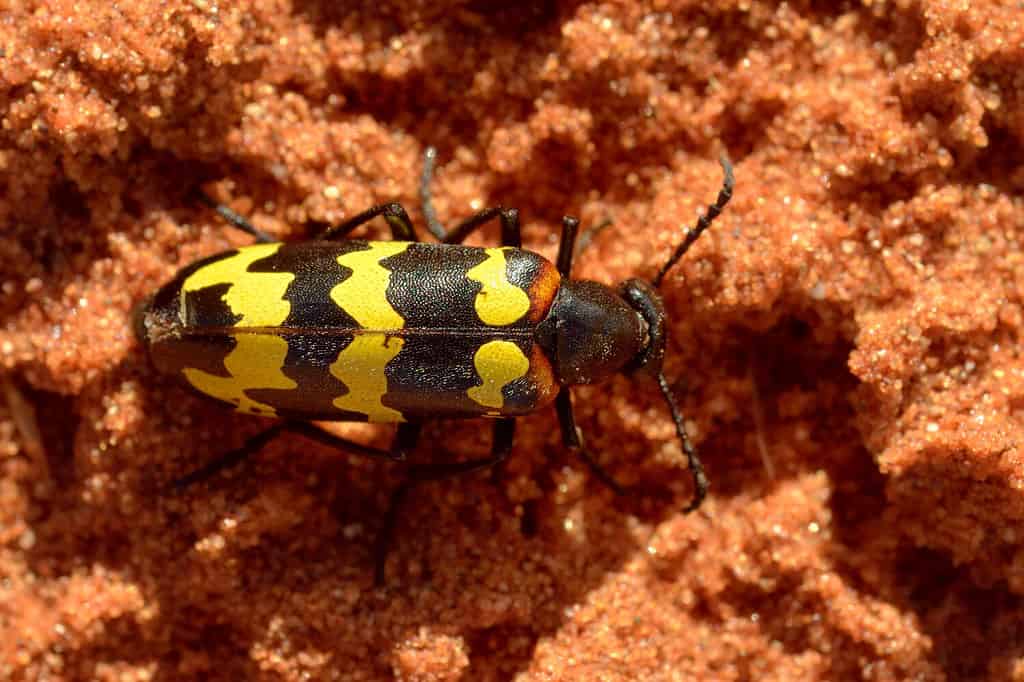
Blister beetles produce cantharidin liquid from their joints which causes blistering.
©D. Kucharski K. Kucharska/Shutterstock.com
11. Sonoran Coral Snake
Arizona is home to 40 different snake species, most of all the U.S. states, so let’s finish up with an epically vivid Arizonian desert snake: the Sonoran coral snake.
Beautiful and deadly, this two-foot-long desert snake has black and red banding separated by creamy white bands. Its black head is slimline, the scales smooth, and its body pencil-thin. It does not appear dangerous, but its bite contains enough venom to kill a human. However, although its venom is stronger than a rattlesnake’s, its fangs are very small and not usually large enough to penetrate skin, clothing, or shoes. No deaths have been reported.
Sonoran coral snakes inhabit remote arid plains, and mountain slopes, and hide beneath large rocks during the day. At night or on cool days, they emerge to hunt other snakes and skinks.
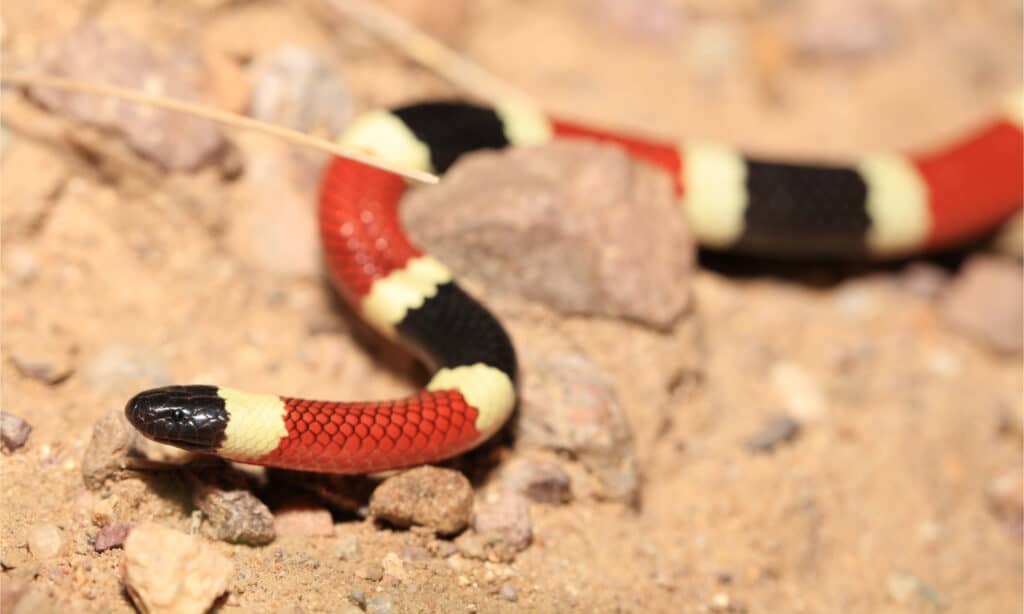
Sonoran coral snakes are attractive but highly venomous.
©Alexander Wong/Shutterstock.com
The photo featured at the top of this post is © DCA88/Shutterstock.com
Thank you for reading! Have some feedback for us? Contact the AZ Animals editorial team.







